Crucified!
A physician explains what Jesus endured the day He died
By Dr. C. Truman Davis
"But He was wounded for our transgressions,
He was bruised for our iniquities;
the chastisement of our peace was upon Him;
and with His stripes we are healed."
Isaiah 53:5
What did the body of Jesus of Nazareth actually endure during His crucifixion? Since crucifixion and scourging were so common during their lifetimes, the gospel writers undoubtedly considered a detailed description superfluous. For that reason, we have only the concise words of the evangelists: "Pilate, having scourged Jesus, delivered Him to them to be crucified...and they crucified Him."
Despite the gospel accounts' silence on the details of Christ's crucifixion, many have looked into this subject in the past. An attempt to examine the infinite psychic and spiritual suffering of the Incarnate God in atonement for the sins of fallen man is beyond the scope of this article. However, we can examine the physiological and anatomical aspects of our Lord's passion in some detail.
Many scholars have attempted to explain away the phenomenon of bloody sweat, apparently under the mistaken impression that it simply does not occur. A great deal of effort could be saved by consulting the medical literature. Though very rare, the phenomenon of hematidrosis, or bloody sweat, is well documented. Under great emotional stress, tiny capillaries in the sweat glands can break, thus mixing blood with sweat. This process alone could have produced marked weakness and possible shock.
The next event in the account which is significant from a medical perspective is His trial before the Sanhedrin and Caiaphas, the High Priest. This is where the first physical trauma was inflicted. A soldier struck Jesus across the face for remaining silent when questioned by Caiaphas. The palace guards then blindfolded Him, taunted Him to identify them as each passed by, spat on Him, and struck Him in the face.
Before Pilate
The scourging was carried out in accordance with Caesar's laws. Jesus was stripped of His clothing and His hands were tied to a post above His head. The Roman legionnaire stepped forward with the flagellum (a short whip consisting of several heavy, leather thongs with small balls of lead attached near the ends of each) in his hand. He brought the flagellum down with full force again and again across Jesus' shoulders, back, and legs. At first the weighted thongs cut through the skin only. Then, as the blows continued, they cut deeper into the subcutaneous tissues, producing first an oozing of blood and finally spurting arterial bleeding from vessels in the underlying muscles.
The balls of lead first produced large deep bruises that were broken open by subsequent blows. Finally, the skin of the back was hanging in long ribbons, and the entire area was an unrecognizable mass of torn, bleeding tissue. When the centurion in charge determined the prisoner was near death, the beating was finally stopped.
After mocking Him and striking Him across the face, the soldiers took the stick and struck Him across the head, driving the thorns deeper into His scalp. Finally, tired of their sadistic sport, they tore the robe from His back. The robe had already become adherent to the clots of blood and serum in the wounds, and its removal caused excruciating pain. The wounds again began to bleed.
In spite of Jesus' efforts to walk erect, the weight of the heavy wooden beam, together with the shock produced by the loss of blood, was too much. He stumbled and fell. The rough wood of the beam gouged into the lacerated skin and muscles of the shoulders. He tried to rise, but human muscles had been pushed beyond their endurance. When the 650-yard journey to Golgotha was finally completed, He was again stripped of His clothing. (There is disagreement as to whether He may have been permitted a loin covering.)
As Jesus sagged down with more weight on the nails in His wrists, excruciating, fiery pain shot along the fingers and up the arms from the nails in the wrists that put pressure on the median nerve. As He pushed himself upward to avoid this stretching torment, He placed His full weight on the nail through His feet. Again there was searing agony as the nail tore through the nerves between the metatarsal bones of His feet.
At this point, another phenomenon occurred. As the arms fatigued, great waves of cramps swept over the muscles, knotting them in deep relentless, throbbing pain. With these cramps came the inability to push Himself upward. Hanging by the arm, the large muscles of the chest were paralyzed and the small muscles between the ribs were unable to act. He could inhale, but He could not exhale. Jesus fought to raise Himself in order to get even one short breath. Finally, as the carbon dioxide level increased in the lungs and blood stream, the cramps partially subsided.
The Last Words
The first — looking down at the Roman soldiers throwing dice for His seamless garment: "Father, forgive them for they do not know what they do."
The second — to the penitent thief: "Today, thou shalt be with me in Paradise."
The third — looking down at His mother, He said: "Woman, behold your son." Then turning to John, the beloved apostle, He said: "Behold your mother."
The fourth cry is from the beginning of Psalm 22: "My God, My God, why have You forsaken Me?"
He suffered hours of limitless pain, cycles of twisting, joint-rending cramps, intermittent partial asphyxiation, and searing pain as tissue was torn from His lacerated back from His movement up and down against the rough timbers of the cross. Then another agony began: a deep crushing pain in the chest as the sac surrounding the heart slowly filled with serum and began to compress the heart.
The prophecy in Psalm 22:14 was being fulfilled: "I am poured out like water, and all my bones are out of joint, my heart is like wax; it is melted in the midst of my bowels."
The end was rapidly approaching. The loss of tissue fluids had reached a critical level; the compressed heart was struggling to pump heavy, thick, sluggish blood to the tissues, and the tortured lungs were making a frantic effort to inhale small gulps of air. Jesus gasped His fifth cry: "I thirst." Again we read in the prophetic Psalm: "My strength is dried up like a potsherd; my tongue cleaveth to my jaws; and thou hast brought me into the dust of death." (Psalm 22:15)
A sponge soaked in cheap sour wine was lifted to Jesus' lips. His body was now in extremis, and He could feel the chill of death creeping through His tissues. This realization brought forth His sixth word, possibly little more than a tortured whisper: "It is finished."
His mission of atonement had been completed. Finally, He could allow His body to die. With one last surge of strength, He once again pressed His torn feet against the nail, straightened His legs, took a deeper breath, and uttered His seventh and last cry: "Father, into Your hands I commit My spirit."
To make doubly sure of death, the legionnaire drove his lance between the ribs, upward through the pericardium and into the heart. (Again, this fulfilled the prophesy spoken by David in Psalm 22:16,17: "They shall look on him whom they pierced.") John 19:34 states, "And immediately there came out blood and water." This escape of watery fluid from the sac surrounding the heart and the blood of the interior of the heart is rather conclusive evidence that Jesus died, not the usual death by suffocation, but of heart failure due to shock and constriction of the heart.
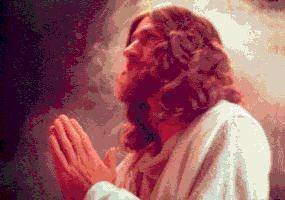 Gethsemane
Gethsemane
The physical passion of Christ began in Gethsemane. Of the many aspects of His initial suffering, the one which is of particular physiological interest is the bloody sweat. The physician, Luke, wrote, "And being in agony, He prayed the longer. And His sweat became as drops of blood, trickling down upon the ground." (Luke 22:44 KJV)
In the early morning, battered and bruised, dehydrated, and worn out from a sleepless night, Jesus was taken across Jerusalem to the Procurator of Judea, Pontius Pilate. Pilate attempted to shift responsibility to Herod. However, Jesus suffered no physical mistreatment at the hands of Herod and was returned to Pilate. It was then, in response to the outcry of the mob, that Pilate condemned Jesus to scourging and crucifixion.
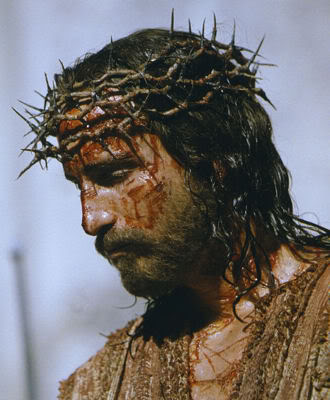 Mockery
Mockery
The half-fainting Jesus was untied and allowed to slump to the stone pavement, wet with his own blood. The Roman soldiers threw a robe across His shoulders and placed a stick in His hand for a scepter. They crafted a crude crown from small branches covered with long thorns, commonly used for kindling fires. They pressed the crown into his scalp, producing copious bleeding as the thorns pierced the vascular tissue.
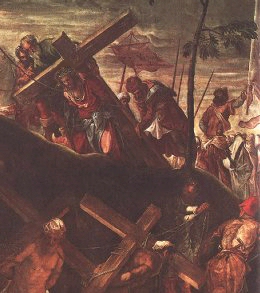 To Golgotha
To Golgotha
In deference to Jewish custom, the Romans apparently returned His garments. The heavy patibulum of the cross was tied across His shoulders. The procession of the condemned Christ, two thieves, and the execution detail of Roman soldiers began its slow journey along the route known as the Via Dolorosa.
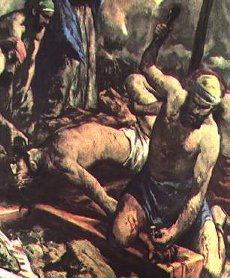 Crucified!
Crucified!
Jesus was offered wine mixed with myrrh (a mild pain-reliving mixture), which He refused. With the patibulum on the ground, Jesus was thrown backward, with His shoulders against the wood. The legionnaire felt for the depression at the front of the wrist and drove a square wrought-iron nail through the wrist and deep into the wood. Quickly, he moved to the other side and repeated the action. They then lifted the patibulum into place at the top of the stipes and dropped it into place. The left foot was pressed against the right foot. With both feet extended toes down, a 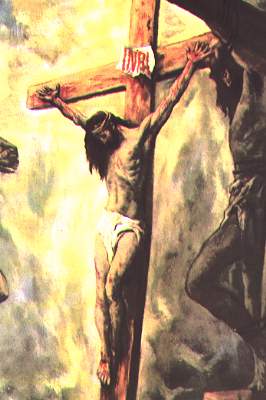 spike was driven through the arch of both feet. The victim was now crucified.
spike was driven through the arch of both feet. The victim was now crucified.
Spasmodically, He was able to push Himself upward to exhale and bring in life-giving oxygen. It was undoubtedly during these periods that He uttered the seven short sentences that are recorded.
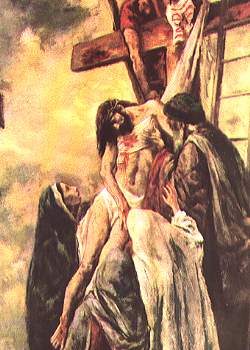 Death
Death
The common method of ending a crucifixion was by breaking the legs. This prevented the victim from pushing himself upward and rapid suffocation occurred. The legs of the two thieves were broken, but when the soldiers approached Jesus, they saw that this was unnecessary. (This, by the way, fulfilled the Law in Exodus 12:46 and Numbers 9:12, which state "Not one of his bones shall be broken.")
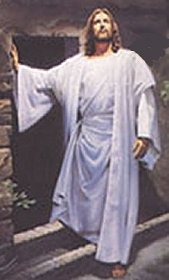
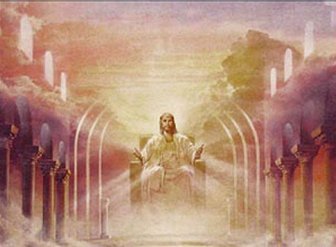
But the crucifixion was not the end of the story! Praise God that we have a sequel: a glimpse of the infinite mercy of God toward man — the gift of atonement, the miracle of the resurrection, and the expectation of that final resurrection morning!

Copyright © 1998-2010 My Redeemer Lives Christian Ministry
Contact the Webservant for source codes, copyright permission,
or if you have comments or suggestions about this site.